Porto city is home to some of the most popular bridges, including the Maria Pia Bridge, Dom Luis I Bridge, and the Sao Joao Bridge. These architectural and engineering marvels serve as vital links and offer breathtaking vistas between Porto and Vila Nova de Gaia. From the iconic double-deck metal arch of Dom Luis I to the contemporary elegance of Sao Joao, each bridge narrates a tale of innovation and historical significance. The Maria Pia Bridge, a testament to the creativity of the industrial age, completes this trio of must-see structures.
What are the Most Famous Bridges In Porto?
The most famous bridges in Porto are the Dom Luís I Bridge, the Ponte Maria Pia, the São João Bridge, the Arrábida Bridge, the Ponte do Freixo, and The Ponte do Infante. The porto dom luis I Bridge, known for its iconic double-deck iron arch, connects Porto with Vila Nova de Gaia across the River Douro. It offers breathtaking views and is a favorite spot for photographers. The São João Bridge, a replacement for the Maria Pia Bridge designed by Gustave Eiffel, serves as a critical rail link.
Its modern design contrasts with the historic architecture of the city. The Arrábida Bridge, celebrated for having the world's longest concrete arch span at the time of its completion, supports vehicular traffic and provides a unique perspective of Porto and the Douro River. Each bridge showcases distinctive engineering marvels and plays a vital role in the city's infrastructure and tourism. Visiting these bridges offers insights into Porto's rich history and spectacular urban landscape.
Dom Luis I Bridge
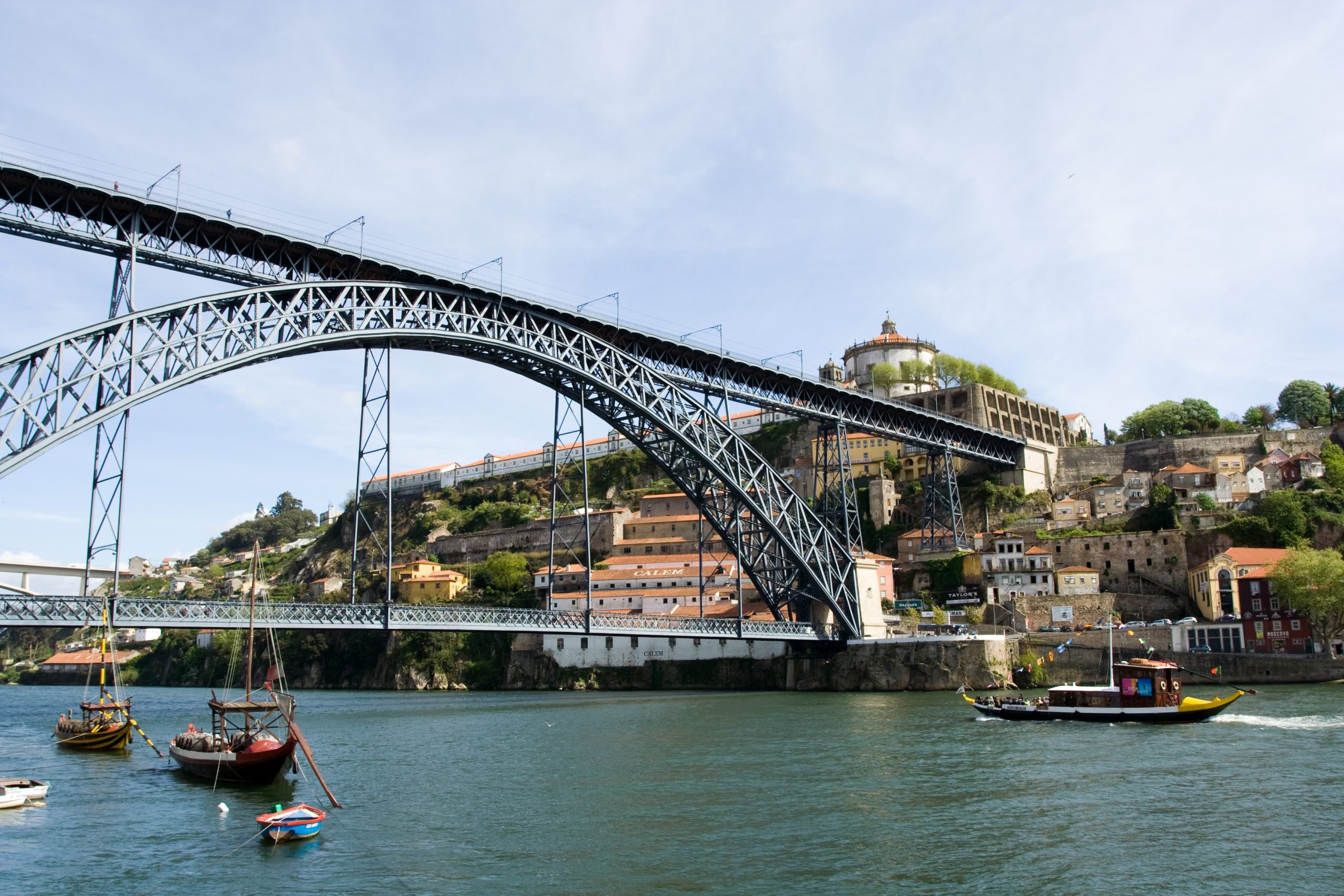
The Ponte de Dom Luis a.k.a the Dom Luis bridge is an iconic structure that spans the Douro River, connecting Porto with Vila Nova de Gaia. It was constructed in the late 19th century, and it stands as a testament to engineering prowess and aesthetic design. The bridge features two levels, supporting both pedestrian and vehicular traffic. Its distinctive architecture and metalwork, designed by a disciple of Gustave Eiffel, the mind behind the Eiffel Tower in Paris, contribute to its recognition as a symbol of the city. From this bridge visitors and locals alike admire the panoramic views of Porto and the river from the bridge, making it a popular spot for photographs and leisurely walks. The Dom Luis I Bridge is not only a vital transportation link but also a cultural landmark, embodying the historical and architectural charm of Porto.
Ponte Maria Pia
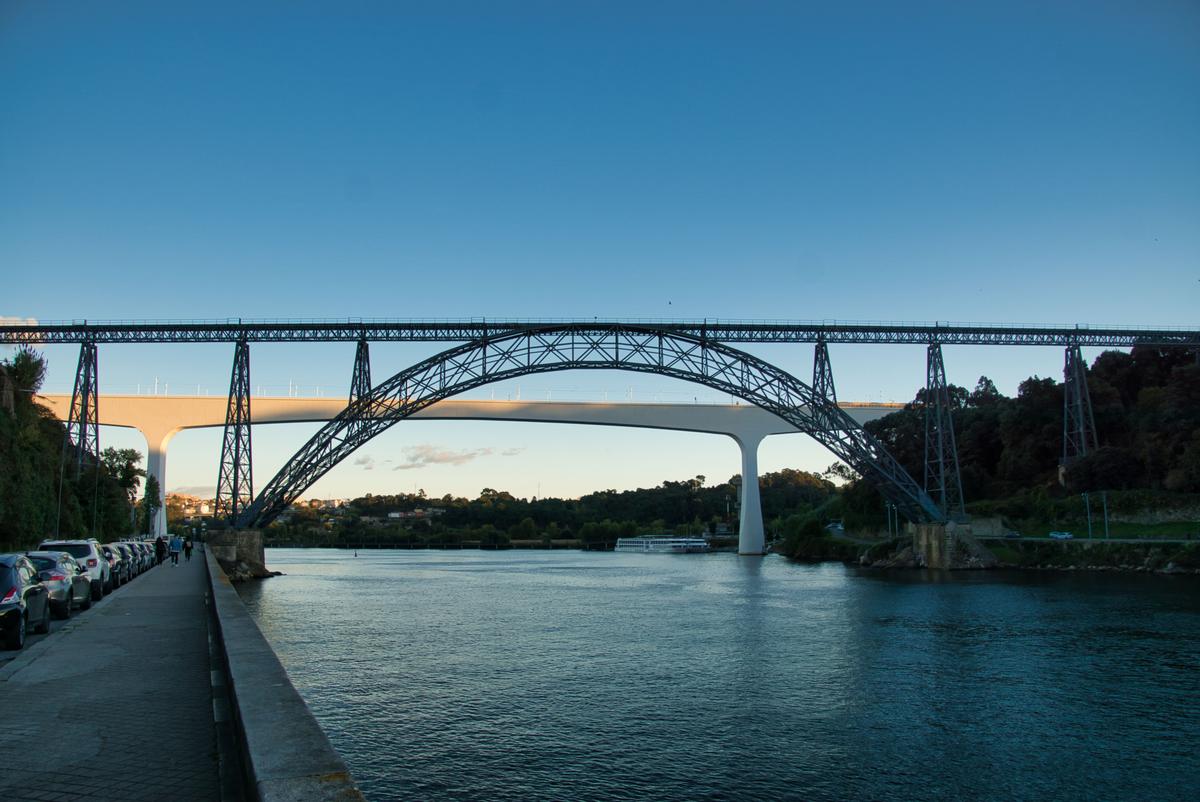
One of the most famous bridges in Porto is the Ponte Maria Pia. This iconic structure also spans the Douro River, connecting Porto to its elegant ironwork and grand scale exemplify the technological advancements of its time. The construction of the first Ponte de Maria Pia marked a significant moment in the history of Porto, showcasing the city's ambition and its pivotal role in the development of railway infrastructure in Portugal. The bridge's design, featuring a single-span architecture that was considered revolutionary, allowed for minimal interference with river navigation, which was a critical consideration for the bustling port of Porto.
Now, the Ponte Maria Pia stands as a testament to human ingenuity and the enduring beauty of industrial architecture. It attracts photographers, historians, and architecture enthusiasts, all drawn to its historical significance and aesthetic appeal. The bridge is often included in tours of the city, offering visitors a glimpse into the engineering prowess of the past.
As a cultural landmark, the Ponte Maria Pia and tower not only contributes to the skyline of Porto but also serves as a reminder of the city's rich history and its connection to the wider world through trade and innovation. Despite the construction of more modern bridges that now handle the heavy traffic across the Douro, the Maria Pia bridge remains a cherished emblem of Porto's legacy and a must-see for anyone visiting the city.
Ponte de São João
The Ponte de São João is third in this list of the most famous bridges in Porto. This railway bridge spans the Douro River, connecting Porto to Vila Nova de Gaia. It was mainly constructed to replace the old Maria Pia Bridge, it stands as a modern engineering marvel which was designed by Edgar Cardoso, it was completed in 1991. The bridge features a sleek, single-arch design, showcasing advanced construction techniques. Its significance extends beyond functionality, serving as a symbol of progress and innovation in Porto. The Ponte de São João not only facilitates vital rail connections but also enhances the scenic beauty of the Douro River banks.
Ponte da Arrabida
Ponte da Arrábida, fourth in the list, this iconic structure also spans the Douro River, connecting Porto to Vila Nova de Gaia. It was constructed in 1963, it stands as a testament to modern engineering and design. Measuring over 500 meters in length, with an arch that soars 52 meters above the river, the bridge is a remarkable sight. Not only does it serve as a vital artery for vehicular traffic, but it also offers pedestrians breathtaking views of the river and the cities it unites. The Ponte da Arrábida is celebrated for its architectural beauty and functionality, making it a must-see landmark in Porto.
Ponte do Freixo
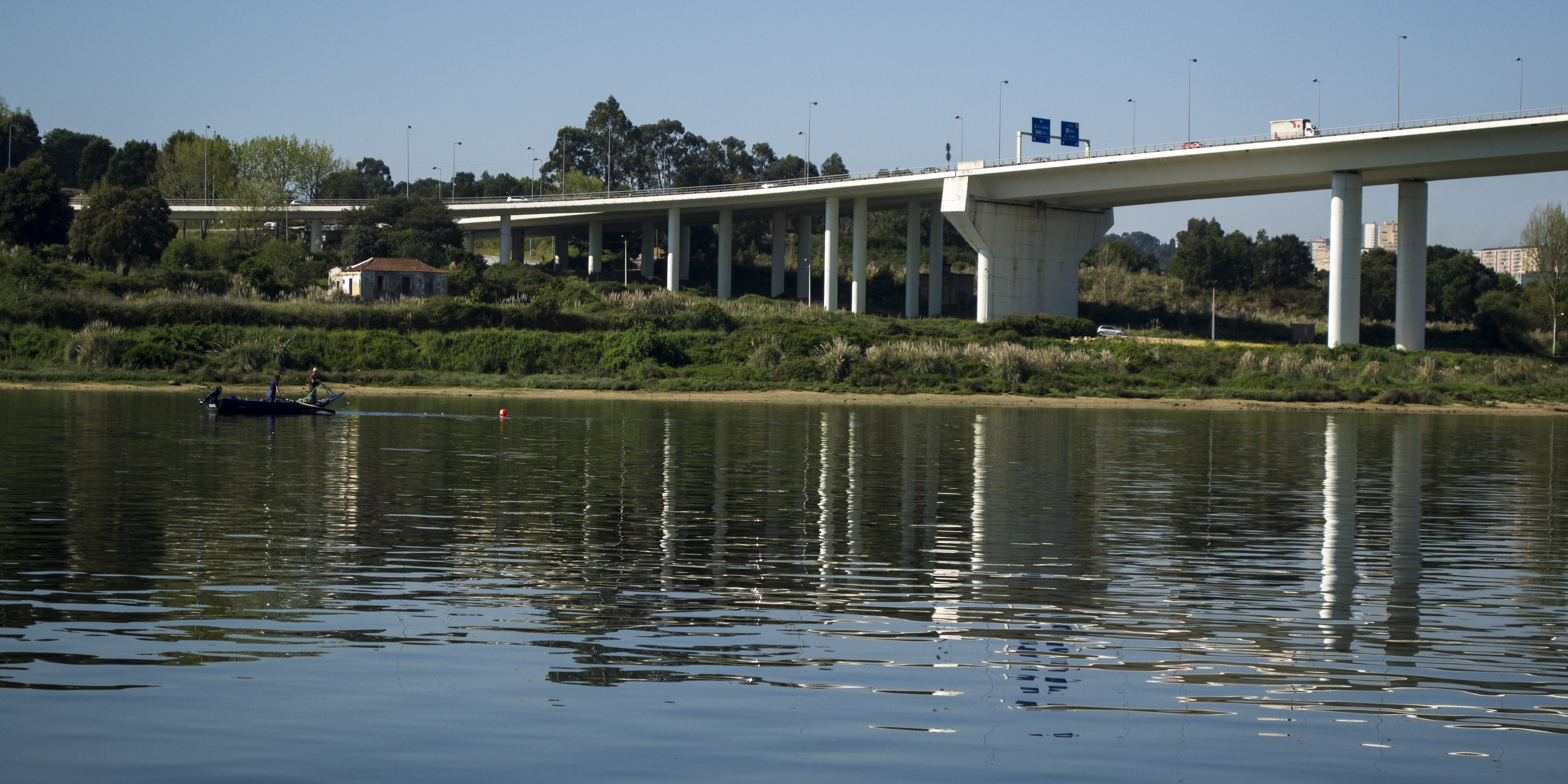
One of the most famous bridges in Porto is the Ponte do Freixo. Situated on the Douro River, this remarkable structure connects Porto with Vila Nova de Gaia. The bridge stands out for its modern engineering and significant capacity to alleviate traffic flow between the two cities. Constructed in the late 20th century, the Ponte do Freixo consists of multiple spans that showcase an impressive blend of functionality and design. It serves as a vital link for commuters, facilitating seamless transportation and contributing to the urban connectivity of the region. The bridge's strategic location and architectural significance make it a notable landmark in Porto's landscape.
Ponte do Infante
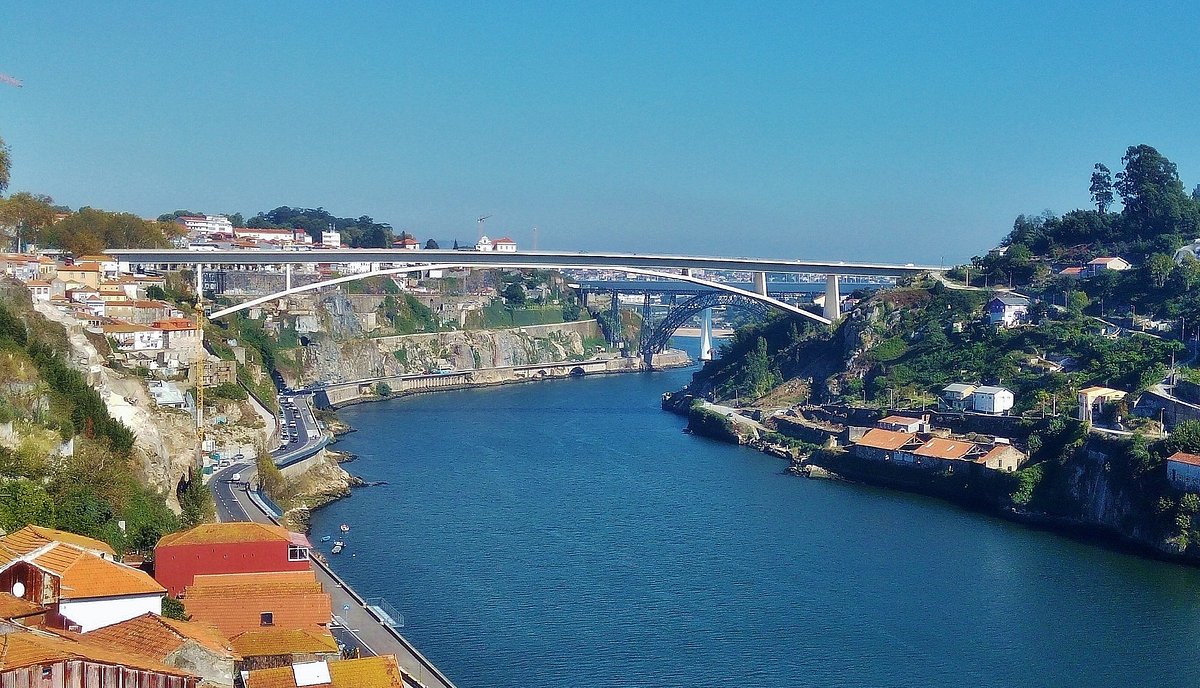
Last but not the least, the Ponte do Infante, this bridge stands as a vital link between Porto and Vila Nova de Gaia. It showcases a remarkable design, characterized by its sleek, single arch. The Ponte do Infante was inaugurated in 2003, replacing the Ponte Maria Pia as the main rail link. Its construction significantly improved traffic flow and accessibility across the Douro River. The famous bridge now not only serves practical purposes but also offers stunning views of the cityscape, making it a favorite spot for photographers and tourists alike. Its architectural elegance and functional importance make it a landmark in Porto’s riverside silhouette.
Tips for Visiting Porto Bridges
Tips for visiting Porto bridges include several strategies to enhance your experience of these iconic structures. First, plan your visit during the early morning or late afternoon for the best lighting and fewer crowds, ideal for capturing stunning photographs of the bridges and the Douro River. Wear comfortable shoes as exploring the bridges and their surroundings often involves walking on uneven surfaces. Consider a douro river cruise, for a unique perspective of the bridges from the water, offering views you can't get from land. Always check the weather forecast before your visit, as Porto's climate can be variable, and you'll want to be prepared for rain or sun. Lastly, don't forget to visit both the Dom Luís I Bridge for its majestic views and the Ponte de São João for a modern architectural perspective.
Walk across the Dom Luís I Bridge for panoramic views
Walking across the Dom Luís I Bridge offers breathtaking panoramic views of Porto. This iconic structure spans the Douro River, connecting Porto to Vila Nova de Gaia. As you traverse this double-decked marvel, the picturesque landscape unfolds, featuring the historic cityscape and the serene river below. The two upper level and lower deck each, exclusively for pedestrians and trams, presents an unobstructed vista of Porto's riverside, adorned with traditional Rabelo boats and bustling riverbanks. The experience is a must-do, capturing the essence of Porto's charm and architectural grandeur. Enjoy the scenic beauty and the vibrant atmosphere of one of Porto's most celebrated bridges.
Take a River Cruise to See all the Bridges
Taking a river cruise is an unparalleled way to view all of Porto's bridges. As you glide along the Douro River, you'll encounter the iconic Dom Luís I Bridge, renowned for its majestic double-deck iron architecture. The cruise offers unique perspectives of the Maria Pia Bridge, a Gustave Eiffel masterpiece, showcasing the ingenuity of 19th-century engineering.

The journey continues past the São João Bridge, a critical link in Porto's transportation network, and the Infante Dom Henrique Bridge, celebrated for its sleek, modern design. Each bridge tells a story, blending historical significance with architectural beauty.
Opt for a sunset cruise to see these structures illuminated against the backdrop of the setting sun, casting a golden glow over the river. This experience not only provides breathtaking views but also offers insight into the city's rich heritage and the evolution of bridge design.
Remember to bring a camera to capture the stunning scenery and the remarkable engineering feats of Porto's bridges. A river cruise provides a memorable and picturesque way to appreciate the city's architectural wonders.
Visit the Serra do Pilar Viewpoint at Sunset
Visiting the Serra do Pilar Viewpoint at sunset is a must for anyone exploring Porto's bridges. This iconic location offers unparalleled views of the Douro River, spanned by the majestic Dom Luís I Bridge. The setting sun bathes the ironwork and the riverbanks in golden hues, transforming the scene into a picturesque masterpiece. The viewpoint provides a panoramic vista that captures the essence of Porto's connection to its waterways and bridges. To maximize your experience, arrive early to secure a spot, as it's a popular destination for both locals and tourists. Remember to bring a camera; the moments you'll capture are unforgettable. Finally, as night falls, watch the city lights begin to twinkle, mirroring the stars above, completing a truly magical experience.
History of Porto Bridges
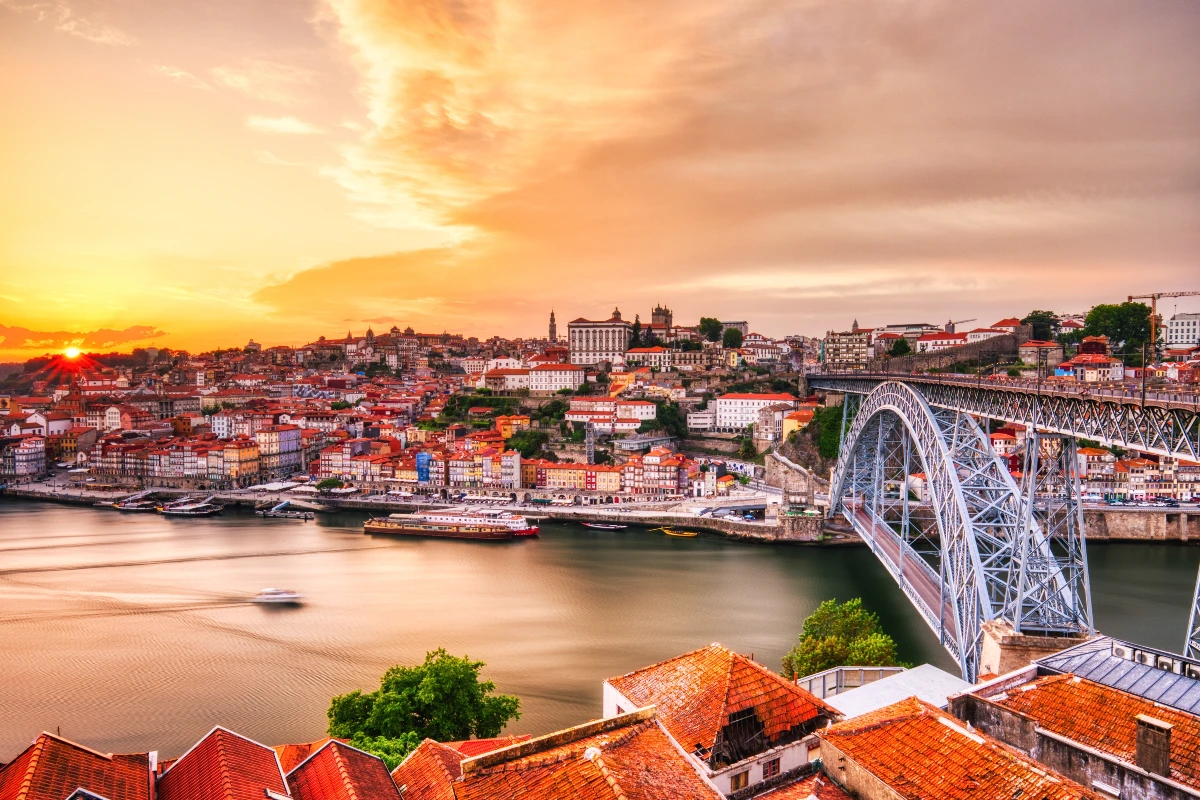
The history of Porto's bridges is as rich and fascinating as the city itself. These structures span the Douro River, connecting Porto to Vila Nova de Gaia. Each bridge tells a story of engineering innovation and cultural significance.
The Dom Luís I Bridge, with its iconic double-deck iron arch, stands as a testament to 19th-century engineering in portugal. Inaugurated in 1886, it symbolizes the industrial era's impact on Porto's development. The Maria Pia Bridge, a creation of Gustave Eiffel, was a marvel of its time when it opened in 1877, showcasing the potential of wrought iron in bridge construction in portugal.
The São João Bridge, completed in 1991, replaced the Maria Pia Bridge for railway traffic, featuring a modern design that contrasts with its predecessors. The Arrábida Bridge, known for having the world's largest concrete arch at the time of its completion in 1963, illustrates advancements in concrete technology.
Visiting these bridges offers not just breathtaking views but also a journey through Porto's historical evolution. Each bridge has its own viewpoint, providing unique perspectives of the city and the river. Early morning or late afternoon are ideal times to capture the beauty of these structures, with the light casting a golden hue over the water.
To fully appreciate Porto's bridges, consider walking across them or taking a river cruise. This allows for an up-close experience of their architectural details and the wonderful views of the surrounding landscape. Remember to wear comfortable shoes and bring a camera to capture photos of the stunning vistas.
In summary, Porto's bridges are more than just transportation links; they are landmarks of cultural heritage and engineering prowess. Their history reflects the city's growth and the technological advancements of their respective eras. A visit to Porto is incomplete without exploring these architectural wonders.
What are the Most Popular Viewpoints of Porto Bridges?
Most popular viewpoints of Porto bridges are Ponte de Dom Luís I, Porto Cathedral & Terreiro da Se Street, Miradouro da Serra do Pilar, and Marginal de Gaia. Among these, the Dom Luís I Bridge stands out, where visitors can enjoy expansive views of the Douro River and the historic Ribeira district from its upper and lower deck above. Another prime spot is the Miradouro da Serra do Pilar, located on the Gaia side of the river, providing a stunning vantage point of not only the Dom Luís I Bridge but also the Maria Pia Bridge and the São João Bridge. The Jardim do Morro, adjacent to the Dom Luís I Bridge, offers another scenic overlook, with lush greenery framing the picturesque cityscape. For a different perspective, the boat tours along the Douro River afford up-close views of these engineering marvels, allowing visitors to appreciate their architectural beauty from the water. Each viewpoint presents a unique angle of Porto’s bridges, capturing the essence of the city's landscape and its rich architectural heritage.
What is the Significance of Porto Bridges?
The significance of Porto bridges extends beyond their primary function of connecting different parts of the city. These iconic structures serve as historical landmarks, offering breathtaking views of the Douro River and the picturesque landscapes of Porto. Each bridge, with its unique architectural design, tells a story of Porto's evolution and its engineering feats.
Among the most famous is the Dom Luís I Bridge, a symbol of Porto's industrial revolution era. This double-deck metal arch bridge not only facilitates vehicular and pedestrian movement but also stands as a testament to the city's innovative spirit. The Maria Pia Bridge, another noteworthy structure, showcases Gustave Eiffel's genius before the construction of the Eiffel Tower. Its railway connection played a crucial role in Porto's development, enhancing trade and mobility.
The São João Bridge, replacing the Maria Pia Bridge for rail traffic, exemplifies modern engineering prowess. Meanwhile, the Arrábida Bridge, once holding the record for the longest concrete arch span, reflects advancements in construction techniques. These two bridges are not just functional; they are scenic viewpoints, offering panoramic vistas that captivate photographers, tourists, and locals alike.
Visiting these bridges provides a unique insight into Porto's cultural and historical narrative. Whether walking across the Dom Luís I Bridge at sunset or admiring the engineering marvel of the Arrábida Bridge, visitors experience the essence of Porto. Tips for visiting include choosing the golden hour for the best views and photography, exploring the surrounding areas for local cuisine, and taking guided tours to learn about the bridges' histories and technical details.
In summary, Porto's bridges are integral to the city's identity, combining utility with beauty. They bridge the past with the present, inviting exploration and appreciation from all who visit.
Architectural Features of Porto Bridges
The architectural features of Porto bridges showcase the city's engineering marvels and aesthetic appeal. Spanning the Douro River, these structures connect Porto to Vila Nova de Gaia, offering breathtaking views and serving as crucial transportation arteries. The Dom Luís I Bridge, a double-deck metal arch bridge, stands as a symbol of Porto's industrial heritage, its towering arch and intricate ironwork reflecting the influence of Gustave Eiffel's design principles. The Maria Pia Bridge, no longer in use for railway services, remains an iconic example of 19th-century engineering, its single arch illustrating advancements in wrought iron construction.
The São João Bridge, designed by Edgar Cardoso, exemplifies modern bridge engineering with its sleek concrete and steel composition, facilitating both rail and pedestrian traffic. The Arrabida Bridge, famous for having the longest concrete arch span at the time of its completion, combines functionality with elegance, its smooth lines harmonizing with the river's natural contours. Each bridge in Porto not only serves a practical purpose but also contributes to the city's skyline, their varied designs and construction techniques offering a comprehensive overview of the evolution of bridge engineering.
Visitors are encouraged to explore these bridges not only for their architectural significance but also for the unique perspectives they provide of Porto and its surroundings. Whether crossing on foot, by car, or by train, the experience of traversing these bridges connects individuals to the rich history and vibrant culture of the city.
Frequently Asked Questions about Bridges in Porto
Q1. How many bridges are there in Porto?
A. Porto boasts a total of six bridges. These bridges span the Douro River and each bridge offers its own unique architectural charm winning design.
Q2. Which bridge in Porto is the third most famous bridge?
A. The Ponte de São João is one of the most famous bridge in Porto, renowned for its iconic single-arch design.
Q3. Can you walk across the Dom Luís I Bridge?
A. Yes, pedestrians can take pedestrian walkway across the upper deck of the Dom Luís I Bridge to enjoy panoramic views of Porto and the Douro River.
Q4. What is the oldest bridge in Porto?
A. The Maria Pia Bridge, designed by Gustave Eiffel, is the oldest bridge in Porto, though it is no longer in use for rail and road traffic.
Q5. Are there guided tours available for the bridges in Porto?
A. Guided tours are available, offering historical insights and stunning views of Porto’s bridges and the surrounding areas.
Q6. Which bridge in Porto offers the best viewpoint?
A. The top deck of Dom Luís I Bridge upper deck offers the best viewpoint, providing expansive views of the city skyline and the Douro River.
Q7. Is there a fee to cross the bridges in Porto?
A. No, there is no fee to the pedestrian walkways across the bridges in Porto, including the Dom Luís I Bridge.
Q8. What is the newest bridge in Porto?
A. The Infante Dom Henrique Bridge is the newest bridge in Porto, enhancing the city’s infrastructure and connectivity.
Q9. Can you see all six bridges from one spot in Porto?
A. The Serra do Pilar viewpoint offers a unique spot where you can see all six bridges that cross the Douro River in Porto
Q10. What safety tips should visitors follow when exploring the bridges in Porto?
A. Visitors should stay on designated paths, be mindful of traffic when on bridges that accommodate vehicles, and wear comfortable shoes for walking.
